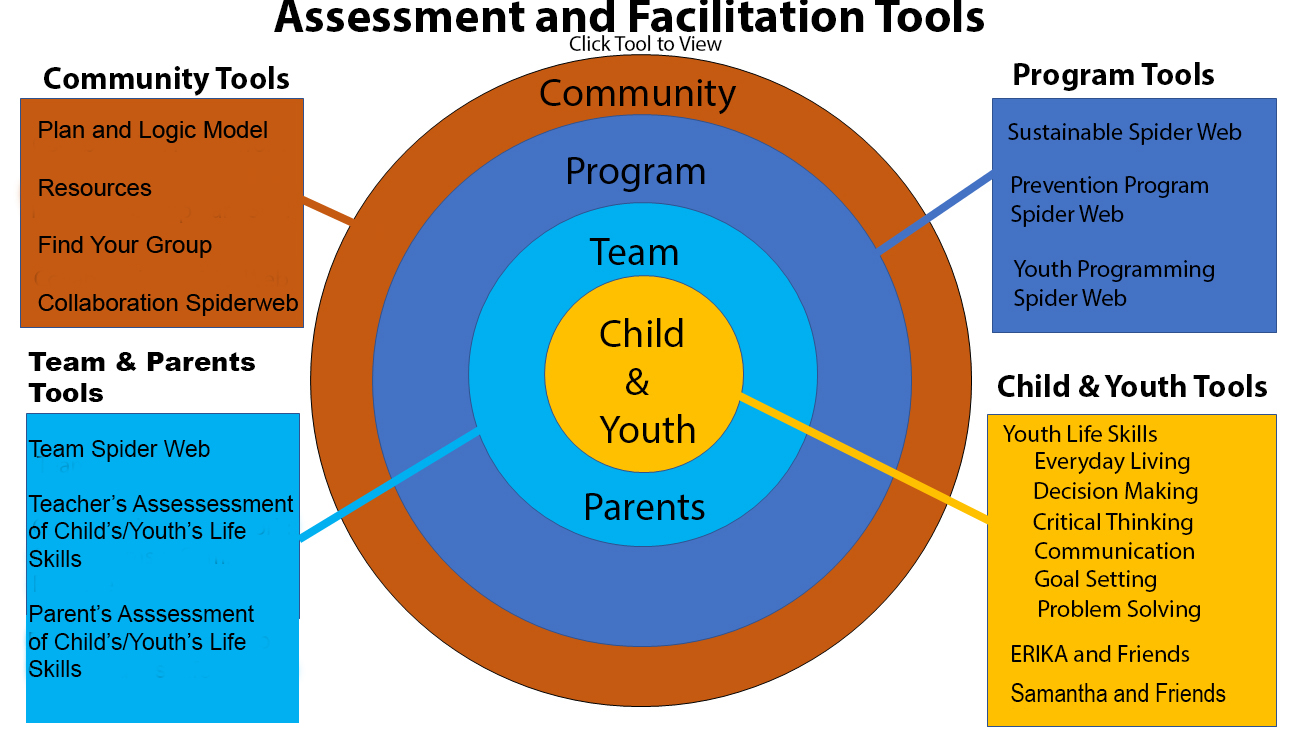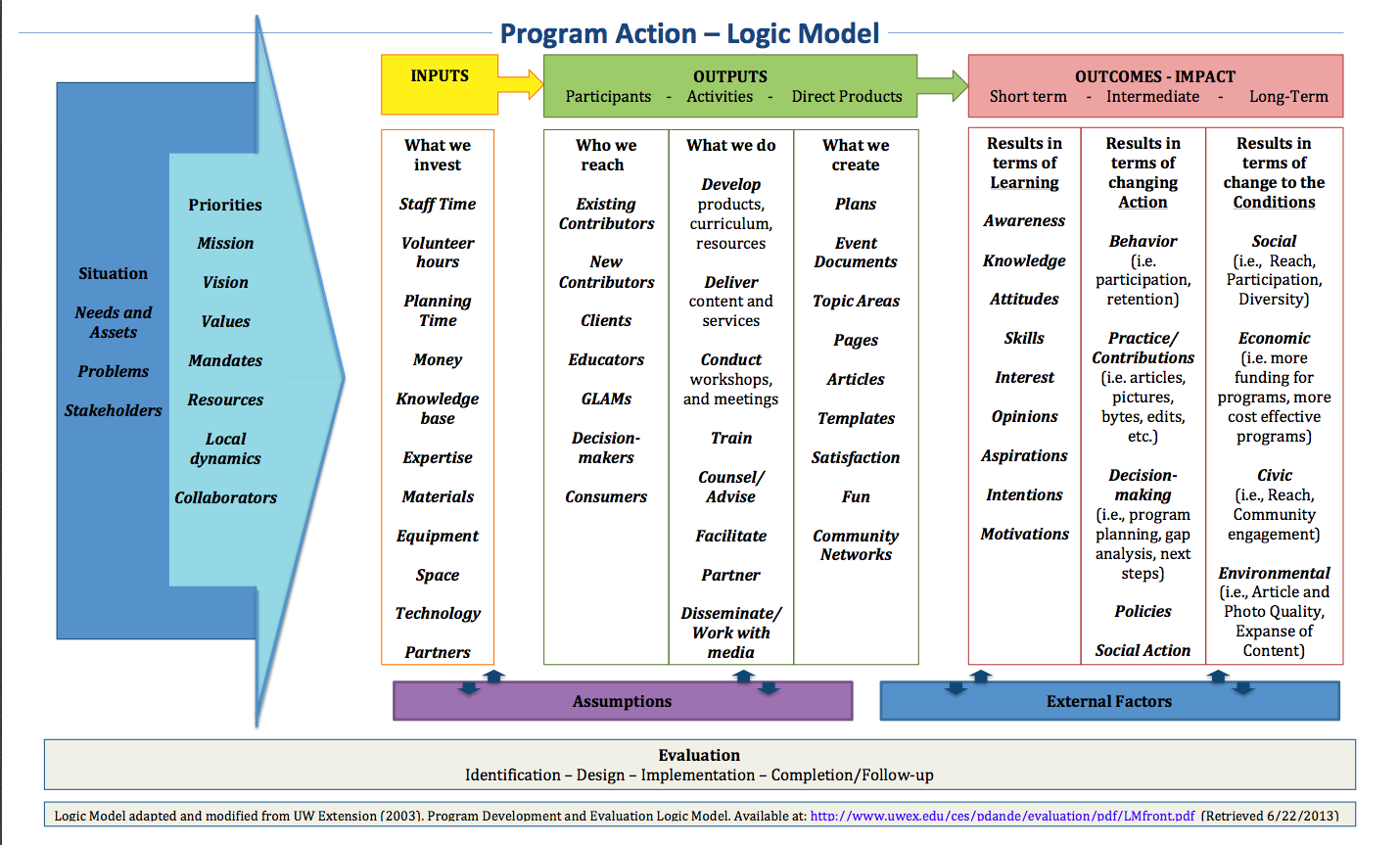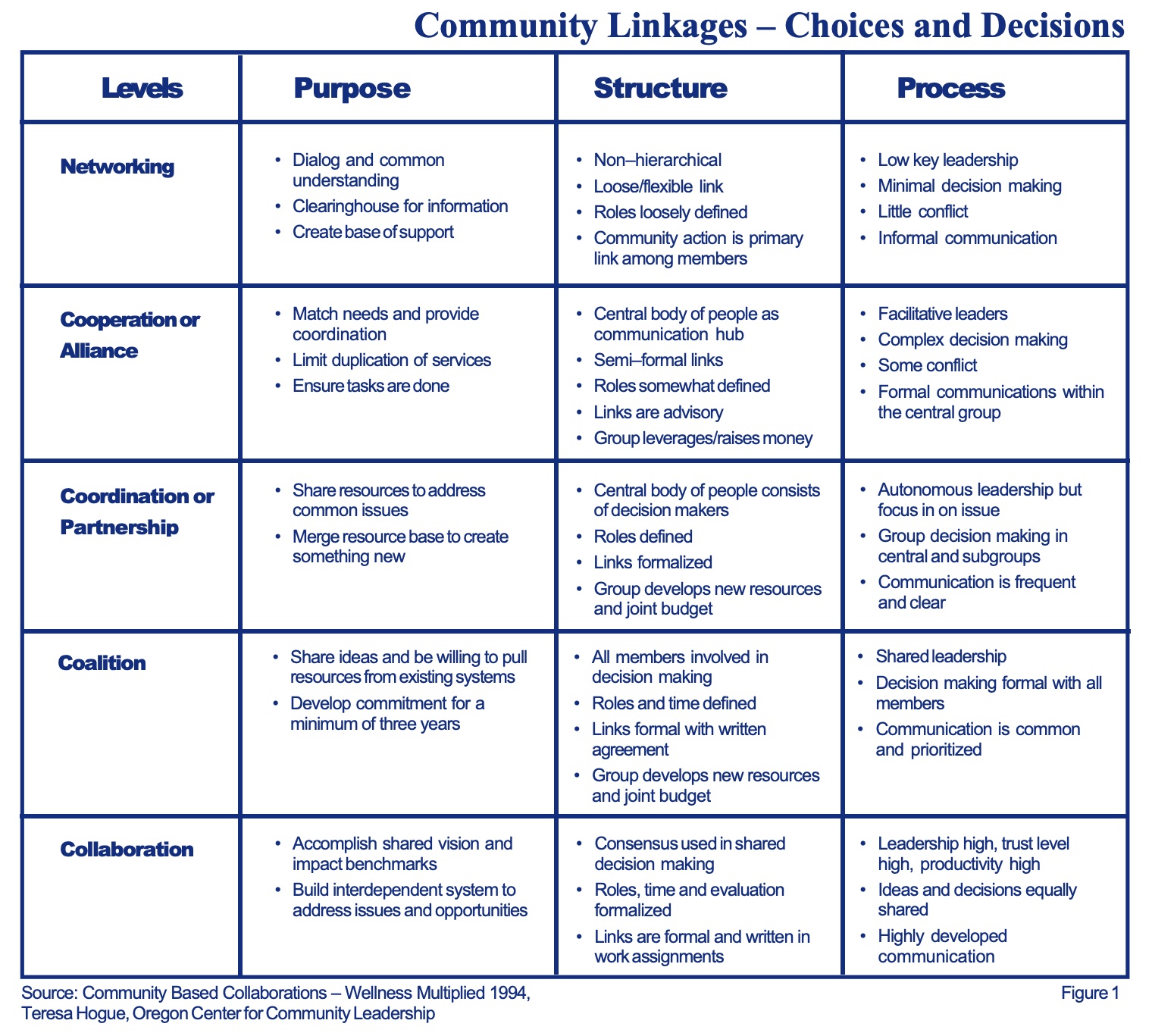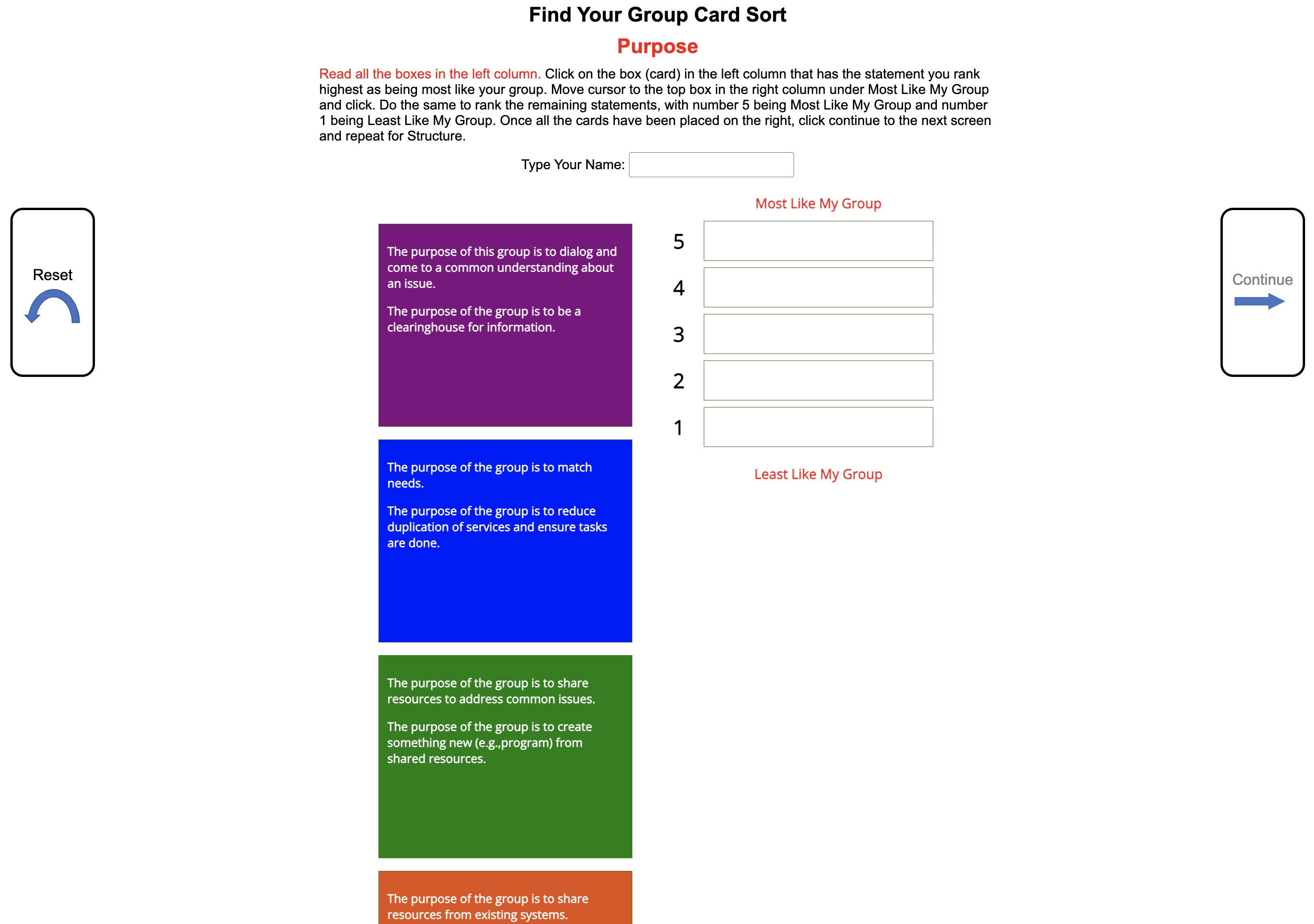

|
The Assessment and Facilitation Tool system is designed to help collect and use information at various levels that range from community needs assessment and facilitation of collaborations to program sustainability and improvement of prevention and youth programs to impacts on youth life skills. Tools can be used in various combinations or independently. Tools can help community members, administrators, teachers, and parents to: assess needs of a community, collaboration, group, program or youth; document change over time (positive or negative) for reports and grants; and provide information for future goals of collaborations and programs. The life skills tools can be used over time to assess changes in children and youth on decision making, critical thinking, communication, goal setting, problem solving, curiosity and creativity, and social consciousness. One of the first questions to be answered in getting started is what tool to pick? We suggest you read through the sub-areas of importance or constructs for each of the tools and examine how well they fit with your objectives and program plan. You may also want to look at the questions within each of the sub-areas of importance for each of the tools. If you have questions or need assistance contact Human Service Research. |
|
Videos (click on the title below to view video) Overview of Assessment and Facilitation Tools Creating a Plan Using the Logic Model Approach Overview of Collaboration Resources |  |
| Plan and Logic Model |
| Creating a Plan based on a Logic Model and reporting against it can help guide your initiative or program. The Logic Model framework will help you integrate and use the Assessment and Facilitation Tools. It will help give you a course to track and determine sucesses and failures (and set the stage for changes in the future) as well as communicate the vision, plan of the group, and results. Evaluation plan builds on the logic model that helps focus data collection and reporting collection, define inputs, outputs, outcomes, and helps to describe sucesses and failures in reaching targeted audiences. Logic Models and evaluation plans may range from one simple one to multiple complex ones based on many factors that include; where the group is at within the life cycle of their iniative; level of inputs like staffing, volunteers, expertise, partners, and resources; different target audiences; direct and indirect outputs; different delivery methods; and the level of outcomes and impacts the group is striving for. |
|
Planning Reporting Logic Model Report Evaluating
|

|
| Collaboration Framework |
| The National Network for Collaboration created a framework of community resources with a training manual and standards of practice in helping children and families. The collaboration framework provides theoretical and practical underpinnings of collaboration. The framework is based on a core foundation of shared vision, mission, principles, and values. It identifies and defines the factors both process and contextual which can promote or inhibit the effectiveness of a collaboration and it's desired outcomes. All the materials in the resources are based on the collaboration framework. The training module is for interested individuals in community based collaborative efforts to build long term positive community assets. The training manual is broken into discrete learning units that provide individuals with the necessary tools to take a group from the earliest conception of formation to evaluation of collaborative efforts. Click on the image for a printable pdf. |
|
|

|
| Find Your Group |
Find Your Group is a tool to help individuals and groups assess the group's level of community linkage for purpose, structure, and process. Understanding and discussing these linkages and the congruency (or possibly incongruency) across the function areas can help the group apply the appropriate level of linkage that can increase the likelihood of a community group achieving shared goals and outcomes. Repeated use of the tool can show if change has occurred (positive or negative). Click on the Community Linkages-Choices and Decisions image for a printable pdf. |
|
Sub-Areas 1. Purpose 2. Structure 3. Process |  |
 |
|
Instructions for implementing the tool manually off-line, printable cards, and scoring worksheet Sample of custom email instructions for on-line Find Your Group Tool Note to use the tool on-line you will need to log into the system and set up a program and survey. |
| Ecomaps |
Ecomaps are useful tools for mapping out the people and things in the picture for the program at the organization level or child at the parent level. In the center is the focus as one maps out people and things, roles and relationships that over time could show change (positive or negative). People and things missing from the picture may say as much as who and what is in the program's or youth's world. The people and organizations in the picture may also be the ones you may want to include in your needs assessments, input on your priorities and plan, and, possibly, resources in the future. |
|
Sub-Areas 1. People and Things Directly and Indirectly 2. Roles 3. Relationships |  |
 |
|
Instructions for implementing the Tool Parent Ecomap Video Note this tool is paperbased only. |
| Collaboration Spider Web |
|
The Collaboration Spider Web evaluation tool identifies factors that influence the collaborative process and allows individuals and groups to determine which factors may need to be strengthened or addressed. Both process and contextual factors are represented on the spiderweb. Reading and understanding the definitions of the factors are critical for individuals to use this tool.
Collaboration Sub-Area Definitions Sample of custom email instructions for Collaboration Spiderweb Note to use the tool on-line you will need to log into the system and set up a program and survey.
|
Sustainability Spider Web |
|
Sustainability of an initiative or program is critical in building community assets and achieving long term outcomes. The Sustainability Spider Web identifies factors that effect sustainability. Individuals should understand the definitions before completing the survey. You can examine the reports as a group or as individuals to examine agreement and disagreements in strenghts and weaknesses that can be enhanced by repeating over time. Sustainability Sub-Area Definitions Sample of custom email instructions for on-line Sustainability Spider Web Note to use the tool on-line you will need to log into the system and set up a program and survey.
|
| Prevention Program Spider Web |
|
An effective prevention program has various degrees of the factors listed below. The Prevention Program Spider Web helps you collect information on how others perceive your program on these factors that can assist in assessment, conversations, planning, and evaluation. Individuals should understand the definitions before completing the survey. You can examine the reports as a group or as individuals to examine agreement and disagreements in strenghts and weaknesses that can be enhanced by repeating over time. Prevention Pttogram Sub-Area Definitions Sample of custom email instructions for on-line Prevention Program Spider Web Note to use the tool on-line you will need to log into the system and set up a program and survey.
|
| Youth Programming Spider Web |
|
An effective youth program has various degrees of the factors listed below. The Youth Program Spider Web helps you collect information on how others perceive your program on these factors that can assist in assessment, conversations, planning, and evaluation. Individuals should understand the definitions before completing the survey. You can examine the reports as a group or as individuals to examine agreement and disagreements in strenghts and weaknesses that can be enhanced by repeating over time. |
|
Youth Program Sub-Area Definitions Sample of custom email instructions for on-line Youth Program Spider Web Note to use the tool on-line you will need to log into the system and set up a program and survey.
|
|
Team Spider Web |
|
An effective team has various degrees of the factors listed below. The Team Program Spider Web helps you collect information on how others perceive your program on these factors that can assist in assessment, conversations, planning, and evaluation. Individuals should understand the definitions before completing the survey. You can examine the reports as a group or as individuals to examine agreement and disagreements in strenghts and weaknesses that can be enhanced by repeating over time. |
|
Team Program Sub-Area Definitions Sample of custom email instructions for on-line Team Program Spider Web Note to use the tool on-line you will need to log into the system and set up a program and survey.
|
|
Youth Life Skills |
|
Accessibility and Human Service Research Human Service Research, Inc. is committed to making the tools and resources accessible as possible to children, youth, and families. To see a video and resources click here. |